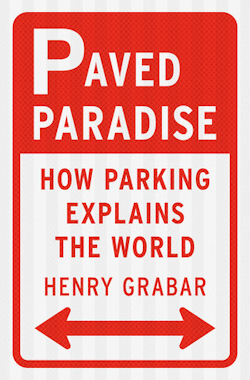SEJournal Online is the digital news magazine of the Society of Environmental Journalists. Learn more about SEJournal Online, including submission, subscription and advertising information.
 |
BookShelf: Why Parking, Long Term, Presents a Lot of Problems
“Paved Paradise: How Parking Explains the World”
By Henry Grabar
Penguin Press, $30
Reviewed by Jennifer Weeks
 |
Full disclosure: Just before I started reading this book, I was meeting up with a big family group for dinner in Philadelphia. We were in a popular neighborhood on a Friday night, and I had spent something like 20 minutes going in ever-larger laps around the restaurant looking for parking.
When my sister called to offer some suggestions, I shouted at her in frustration and then hung up. We made it to dinner 15 or 20 minutes later, in a very bad mood.
So I felt both better — and worse — after reading “Paved Paradise: How Parking Explains the World,” written by Slate staff writer Henry Grabar.
The book provides a broad look at how parking has remade American cities and contributed to many urban problems. It was good to know that I’m far from the first person to have blown their stack over parking — but as Grabar points out, this makes no sense.
“We expect parking to be immediately available, directly in front of our destination and most important, free,” Grabar writes. “This is unique. It would be unimaginable to hold any other good or service to the same standard.”
How parking can warp cities
Grabar shows with engaging examples how parking has warped U.S. cities in numerous ways. One of the clearest examples is minimum parking requirements for all kinds of businesses and developments, from grocery stores to apartments to tattoo parlors.
These policies reshape all kinds of projects, because making owners allocate specific (and, usually, excessive) amounts of space for parking leaves less for the actual destination.
And it’s a pressing problem for the construction of affordable housing.
“Laws that require every building to include parking prevent us from creating housing, especially affordable housing, because parking costs so much to construct and takes up so much space,” Grabar observes.
He offers accounts of specific projects in which parking requirements drove up the unit cost of apartments by many thousands of dollars, even when the intended tenants didn’t necessarily need it.
Many U.S. cities contributed to the
hollowing out of their downtowns
by requiring homes, offices and
businesses to be built with parking spaces.
Many U.S. cities contributed to the hollowing out of their downtowns in the 1950s and 1960s by requiring homes, offices and businesses to be built with parking spaces.
Ultimately, cities built way too much of it, with unintended results: Traffic got heavier and ridership on public transit cratered.
Environmental impacts also abound
Turning big swaths of central cities into parking lots and garages also had major environmental impacts.
Millions of acres of natural land were lost to development and urban heat islands expanded. Flooding became more intense as paved surfaces covered more and more ground. Stormwater runoff from urban areas picked up all kinds of wastes flowing over pavement.
Worst of all, encouraging more driving boosted ground-level air pollution and climate change. Today, transportation is the largest source of U.S. greenhouse gas emissions.
On the upside, parking restrictions offer a lot of leverage over social and environmental problems. As Grabar puts it: “If you want lower emissions and fewer car accidents, parking is the place to start.”
Exploring parking-light
Many U.S. cities are starting to get rid of parking minimums and finding that they get more housing at lower unit costs. Apartment buildings can rent space for residents in nearby office garages, which are empty at night and on weekends — exactly when downtown residents want to park.
For every developer who figures out
how to thread the needle and get
parking-light projects approved,
others default to parking-heavy designs.
But the pace of change is slow. And for every developer who figures out how to thread the needle and get parking-light projects approved, others default to parking-heavy designs.
Grabar finds hope in recent efforts to chip away at single-family zoning, which reflects the car-centered lifestyle. In California, which has legalized accessory dwelling units statewide, many new ADUs, or accessory dwelling units, are either converted garages or small homes that replace existing garages.
Another positive sign is efforts in New York to improve bike lanes, take back street space from cars and eliminate double-parking (every double-parked van removes a lane of traffic from circulation).
Private companies have sprung up to help cities quantify the value of curb space and identify the best uses of it — for example, creating “smart zones” that delivery trucks can reserve for specific time windows.
Grabar’s central point is the importance of thinking differently about parking.
“Parking is access. But it is access of the most superficial sort, one that often pairs over deeper inequities we’re unwilling to address,” he writes.
In most cases, he argues, “parking stands for a primitive kind of access that both overshadows and impedes a more profound and widely held right to the city.”
Jennifer Weeks is senior editor for environment and cities at The Conversation U.S. and a former Society of Environmental Journalists board member. She is a contributing editor to SEJournal and a regular writer for BookShelf. Her last review was about beach exploitation.
* From the weekly news magazine SEJournal Online, Vol. 9, No. 9. Content from each new issue of SEJournal Online is available to the public via the SEJournal Online main page. Subscribe to the e-newsletter here. And see past issues of the SEJournal archived here.












 Advertisement
Advertisement 



